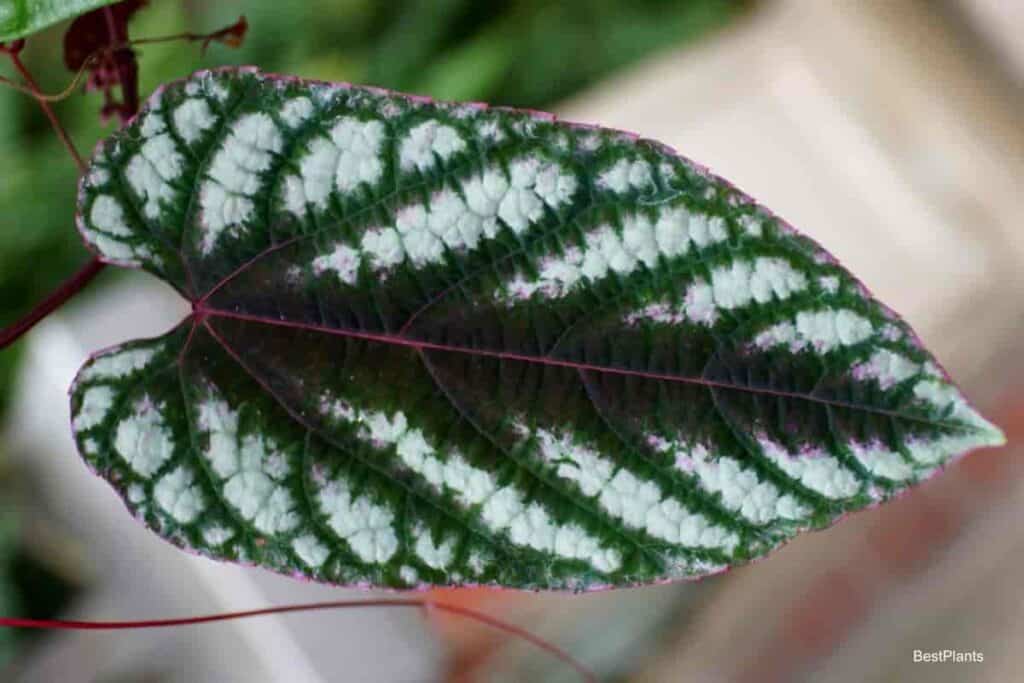One of the more interesting genera out there, Cissus (SIS-us), had more than 350 different species that are mostly vining plants.

Best known as the following common names:
- Treebine
- Grape ivy
- Kangaroo ivy (the genus name means “ivy”), this member of the Vitaceae family, is closely related to grapes.
You can find species occurring naturally in tropical and subtropical regions all over the world.
Treebine Care
Size And Growth
These vines can vary greatly in size, but Cissus alata provides a good example of the size, ranging from 6’ to 10’ feet long and 3’ to 6’ feet wide.
As is often the case, Cissus tends to be smaller when grown indoors or in containers, and will only reach its full potential size if properly supported.
Most species use tendrils to cling to trees and other supports to climb skyward.
The leaves are usually shiny and serrated, most often appearing on trios.
It’s not uncommon for the plants to be grown purely for their foliage.
Depending on the species and amount of light, the leaves can range in size from 2” to 9” inches long and can be medium to dark green.
Several species, such as Cissus quadrangularis, are succulent.
Flowering And Fragrance
Those species which produce flowers domestically tend to have insignificant blooms or greenish-yellow or red.
However, these blooms give way to small blue-black berries that are similar to wild grapes and are often known to attract birds.
Light And Temperature
As they are adapted to climbing trees, Cissus plants are sensitive to direct sunlight.
However, filtered or bright, indirect sunlight is ideal.
The plants will tolerate light to partial shade for short periods but may become leggy if they lose too much light exposure.
Bright morning exposure with some light shade in the early afternoon is a good option in hotter climates.
Cissus plants aren’t too picky about humidity, and average household levels are generally perfect.
When the humidity gets too low, there may be some drying out or browning of the leaves, and high levels leave the plant susceptible to fungal infections.
As tropical plants, Cissus isn’t adapted to temperatures below 50° degrees Fahrenheit and will begin to suffer damage if the temperature drops below 45° degrees Fahrenheit.
Daytime temperatures of 68° to 82° degrees Fahrenheit are best, although nighttime temperatures can be around 10° degrees Fahrenheit cooler.
While the plant can handle temperatures slightly above or below this range, it will hinder growth.
When growing outdoors, the Cissus plant is usually best kept in USDA hardiness zones 10 to 12, but some species and cultivars can handle slightly cooler regions.
Watering And Feeding
This genus easily gets stressed from too much or too little water.
The soak and dry method is generally best.
Here are the tips on how to water and feed a Cissus plant:
- Water only when the soil is dry halfway down and go lightly and evenly until moisture begins to seep from the container’s drainage holes.
- Room temperature distilled water or natural rainwater is best.
- Cut back on watering during the dormant season.
- These plants don’t require a lot of soil-based nutrients, but you can feed them to encourage faster growth.
- Use a balanced liquid houseplant fertilizer diluted to ¼ strength monthly in spring and summer, pausing during the colder months of fall and winter.
Soil And Transplanting
Choose an acidic potting mix with a pH of 5.5 to 6.2 that is well-draining.
The roots need plenty of aeration, so be sure to augment the soil with an aggregate such as perlite.
Some growers prefer to use a blend of bark, opeat, and perlite.
Note that when using peat, you may also have to add some dolomite to prevent the soil from becoming too acidic.
These plants tend to be fairly slow growers and will generally only need repotting every two years or so to replenish the soil and prevent root binding.
Aim for a heavy container to prevent tipping and add a bamboo pole or other support structure.
Grooming And Maintenance
You can prune these plants aggressively in March to encourage growth.
In addition, pinching the tips will often result in thicker stems and a fuller appearance.
How To Propagate Kangaroo Ivy?
These plants may be propagated primarily through air layering and stem or leaf cuttings, usually in the spring.
They may also be grown from seed, although this is rarely done.
Grape Ivy Pests Or Diseases
While fairly easy to grow, Cissus is neither cold-hardy nor drought tolerant.
Spider mites can be a problem if the air is dry.
Other common pests include:
- Aphids
- Caterpillars
- Fungus gnats
- Mealybugs
- Scale
- Slugs
- Thrips.
Potential diseases include:
- Anthracnose
- Botrytis blight,
- Pestalotiopsis dieback
- Powdery mildew
- Rhizoctonia aerial blight
- Root rot.
Cissus is generally considered non-toxic to humans and pets.
However, the sap contains natural latex, which may cause allergic reactions in sensitive individuals.
Additionally, pets may experience indigestion if they snack too much on one of these plants.
Cissus Uses
These plants are very popular in hanging baskets and love being trained onto trellises and similar supports.
The entire genus is attractive to bees.
Cissus quadrangularis is currently being studied for possible medical applications, while several other popular species are grown as ornamentals.